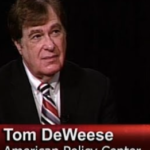Animal ID, Another View
 James Clement, DVM |
Comments By James Clement, DVM, Cow-Calf Research & Consulting, regarding the Ron DeHaven / AVMA News Release on Animal ID
3/9/2010
Dr. Ron DeHaven, Executive Vice President of the American Veterinary Medical Association (AVMA) in a recent press release and AVMA TV video presentation criticizes USDA for including cattle branding as an acceptable form of animal identification. In the video, Dehaven refers to cattle branding as an outdated form of theft deterrent and also states, “It’s hard for me to imagine how this ancient technology will fit into a modern, interstate system to trace animals.”
As an AVMA member I would hope that official statements made by the AVMA Executive VP would be fact based. Dr. Dehaven’s statements regarding State Brand Inspection Systems (SBIS) are inaccurate and are testimony to his lack of cattle industry knowledge. Common misunderstandings about the roles served by SBIS in animal disease investigations are assumptions that the value resides only with the ID / brand. The value is in the information generated. Animal tracking data is generated every day in Brand States and is the byproduct of routine record-keeping processes that involve cattle marketing businesses and SBIS. SBIS create inspection certificates associated with the movement of 27,000,000 head of livestock (primarily cattle) on an annual basis. SBIS are anything but “outdated forms of theft deterrents”. SBIS utilize a variety of modern electronic data processing technologies. SBIS have turn-key workforces, local knowledge, local authority and local respect.
The US Animal Identification Plan (USAIP) forerunner of the NAIS was initiated in 2002. The USAIP was composed of working groups that represented major animal species. Seventy individuals representing producers, allied industries, and state and federal animal health officials made up the Cattle Working Group.
Thirteen guiding principles were agreed upon by the cattle working group. One of the 13 principles was specific to SBIS and is as follows, “Existing State Brand Inspection Systems should be recognized and utilized, whenever possible. USDA / APHIS is encouraged to thoroughly investigate opportunities for integrating State Brand Inspection with the NAIS.” As the USAIP guiding principle states SBIS have value and should be included in any new efforts to resurrect the NAIS.
The following paragraph describes SBIS processes and attributes that benefit animal disease investigations and tracking efforts. Cattle (branded and non-branded) that are marketed through livestock sales businesses located in brand areas are inspected at receiving and cleared for transport and ownership to new premises after purchase. Brands and brand certificates are legal title. Title is transferred through bills of sale or brand certificates. Buyer invoices generated by cattle marketing business are used to create brand certificates. Information transferred from buyer invoices to brand certificates is accurate because real dollars and title are being transferred. Also, cattle inventories are reconciled at the end of the sale. Accurate information describing market cohort groups (consigned cattle and purchased cattle) is available through sale recap documents. Data provided through check-in, sale and brand documents can be codified and animals and premises associated with these documents can be described according to NAIS data standards, e.g. Group Lot ID Numbers and Premises ID Numbers.
Emergency management of diseases such as Foot and Mouth Disease will require immediate identification of all potentially exposed livestock. The information generated by SBIS automatically identifies market cohort groups. Full participation in animal tagging and movement reporting would be necessary for the NAIS to identify the same market cohorts. Also movement documents listing animal IDs and associated premises are technically not movement documents but sighting documents. This is because premises of origin and premises of destination are not linked until sighting documents from both locals are received and processed by the animal tracking databases. In order for the NAIS to generate the same market cohort information that is automatically generated by SBIS the following would need to take place:
- All cattle consigned must be identified with RFID tags and scanned into the livestock market.
- At Check-in sighting documents listing the RFIDs moved out from the premises of origin must be created and forwarded to an Animal Tracking Database (ATD).
- At Check-in, sighting documents listing the RFIDs moved into the market premises must be created and forwarded to an Animal Tracking Database (ATD) because the protocols developed by USDA would not allow origin and destination to appear on the same certificate.
- After cattle are sold, RFID tags are scanned prior to assembly into buyer pens.
- All cattle leaving must be identified as to truckload lots either through load-out RFID scanning or by combining the data associated with the appropriate buyer pen scans.
- At load-out, sighting documents listing the RFIDs moved out from the market premises must be created and forwarded to an Animal Tracking Database (ATD).
- Upon arrival at the new owners premises sighting documents listing the RFIDs moved in from the market premises must be created and forwarded to an Animal Tracking Database (ATD).
NAIS policy dictated that the bulleted steps listed above were to occur in a voluntary atmosphere.
Dr. Dehaven implies that this process would be superior to the SBIS methods used to identify market cohorts.
Events and emotion surrounding the first US, BSE case (Canadian origin cow residing in Washington State) provided the momentum for NAIS implementation to commence. Initially outreach efforts described participation in NAIS as voluntary with a probable shift to mandatory being the eventual reality. Cost and data confidentiality were major producer / stakeholder issues. Implementation was divided into 3 phases (Premises Registration, Animal Identification and Animal Tracking). Federal legislation was drafted late in 2004 to create Freedom of Information Act (FOIA) exemptions for producer and stakeholder data being submitted to the NAIS. By midyear 2005 no one from USDA was championing the FOIA legislation and on August 30, 2005, Secretary of Agriculture Mike Johanns announced that a publicly held database theoretically would be open to access under FOIA and that Animal ID data held or maintained in a private system assures the confidentiality of producer information, therefore USDA policy would be that animal movement data would be maintained in a private system.
 James C. Clement,DVM James C. Clement,DVMCow-Calf Research & Consulting 2248 Sunny Rd South Mandan, ND 58554 701-663-6800 ( Office and Fax) 701-663-6806 ( Home) 701-220-0375 ( Mobile) Email: jclement@bis.midco.net |
The August 30th Johanns plan was essentially the National Cattlemen’s Beef Association’s Animal ID Commission plan and a less than stellar example of special interest lobbying.
Many of the USAIP animal species group members were outraged to say the least and by early 2006 different data management plans were proposed and the ATD ATPS model was finally adopted. USDA’s credibility was damaged, disharmony and delays associated with issues surrounding the NAIS data management policy were kind of the beginning of the end.
Dr. Dehaven was the APHIS administrator before and during NAIS implementation and also when Secretary Johanns announced the change of plan on August 30,2005.
The hubris and lack of understanding associated with Dr.Dehaven’s message is disturbing and quite frankly, unbelievable. State and Tribal Animal Health Officials and the individuals and organizations associated with SBIS are the recipient of his insults. These entities were the common denominator associated with the few NAIS success stories. If a new Animal ID effort is ever to be successful it will have to start with local street-smart workforces, that come equipped with local knowledge, local authority, and local respect.
… JClement
Source: James C. Clement, DVM
Cow-Calf Research & Consulting



